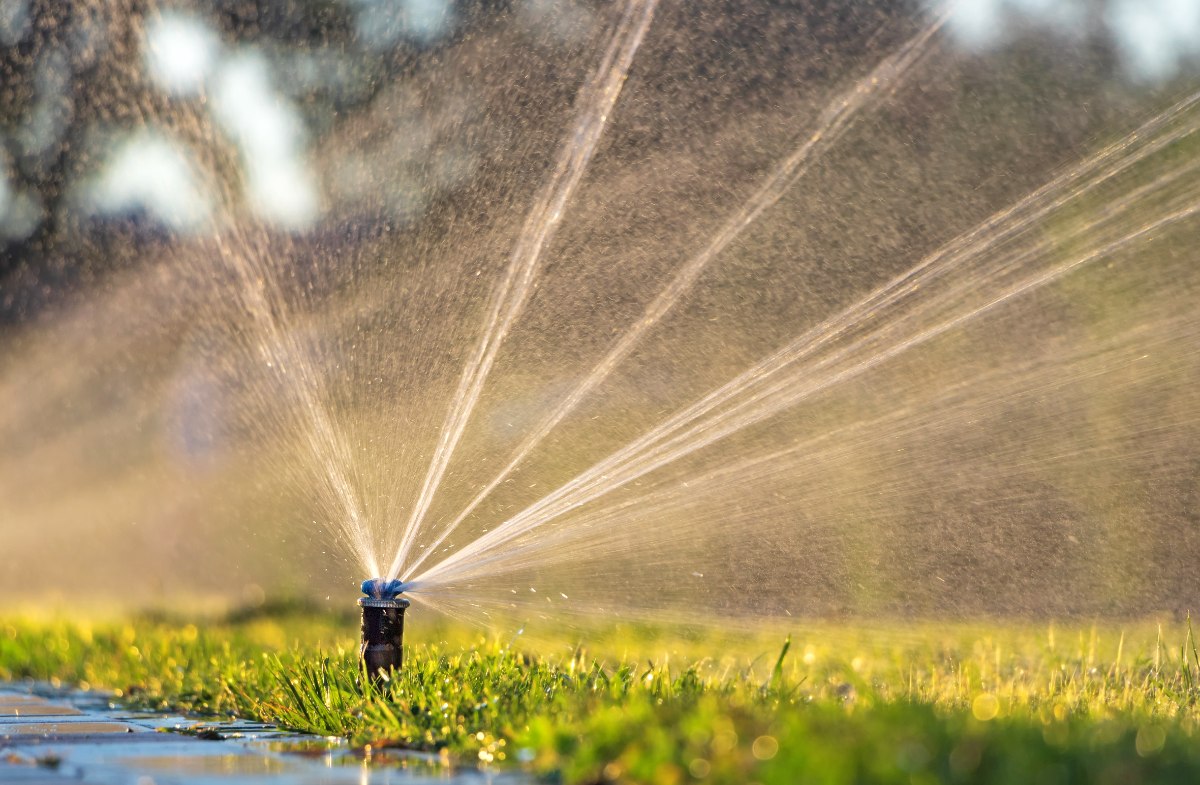
It’s not easy keeping your lawn looking its best in Houston. Our clay soil, blistering summers, sudden storms, and changing water rules demand a sound lawn care strategy.
Here it is: Get about 1 to 1.5 inches of water on your lawn in the heat of summer if Mother Nature isn’t providing enough. Water deeply each time, and when you do water, be sure to get those sprinklers going early in the day before the midday sun steals it all through evaporation.
| Houston Watering Guide At A Glance Best watering time: Before 9 a.m., when temperatures are cooler, to avoid evaporation Weekly water needs: About 1 to 1.25 inches per week, including rainfall, during the spring and summer; about half an inch in the fall. Watering frequency: On average, 1/2 inch twice weekly in the peak months, rather than frequent, light watering Clay soil tip: Houston’s clay soil absorbs water slowly. Water your lawn for longer periods at a slower pace to prevent water from running off. |
Water Early
Water your lawn early in the morning (4-9 a.m.) when it’s cooler and less windy so it doesn’t evaporate in the harsh midday sun. You can also water after 7 p.m., but make sure the grass can dry before nightfall. Grass that stays soggy too long can develop fungal diseases.
How to tell if your grass needs water: Look for grass that appears dull or dark, grass blades that curl or fold, footprints that stay visible after walking on the lawn, and dry soil when you check below the surface. These signs help you water only when needed, saving water while keeping your lawn healthy.
Related reading: When to Water After Applying Weed and Feed
Water Deeply Each Time
The Texas Water Development Board says you should water deeply enough to wet the soil 4 to 6 inches deep to help grass develop strong roots. To achieve this, water twice a week (including rainfall), for about a half hour per zone during the spring and summer. Cut your irrigation by half in the fall.
Still not sure? Check Texas A&M Extension’s watermyyard.org for watering schedules in Houston based on your current weather conditions.
Related Reading:
- How Long Should I Water My Lawn?
- How to Keep Your Grass Alive in Record Heat (Tips from LawnStarter Pros)
Water According to Grass Type

Most Houston lawns have warm-season grasses that grow well in hot, humid weather. The type of grass you have in your yard will determine how much water it needs.
| Type of Grass | Water Needs (Weekly Average) |
| St. Augustinegrass | 1 to 1.5 inches |
| Bermudagrass | 1 to 1.25 inches |
| Zoysiagrass | 1 inch |
| Centipedegrass | 1 inch |
| Seashore Paspalum | 1 to 1.5 inches |
Related Reading: Best Grass Types for Houston
Adjust Watering Seasonally
Houston’s climate varies significantly throughout the year, requiring adjustments to your lawn watering schedule each season.
| Season | How to Water |
| Spring (March-May) | As temperatures rise and lawns emerge from dormancy, gradually increase watering to about 1 inch per week, split between two sessions. Monitor spring rainfall, which may supply much of this needed moisture. |
| Summer (June-August) | In Houston’s hot, humid summers, your lawn needs regular water. Give it 1 to 1.25 inches of water each week. During very hot periods, you might need to water a bit more. Water early in the morning to prevent water loss from heat. |
| Fall (September-November) | Fall brings heavy rains during hurricane season. Keep an eye on the weather forecast and change your watering schedule as needed. When it gets cooler later in fall, cut back watering to about 0.75 inches per week. |
| Winter (December-February) | Watering during winter is rarely needed except during extended dry spells, according to TWDB recommendations. Turn off automatic systems and water manually only when necessary. |
Related Reading:
Test Your Sprinkler System

Before setting up your watering schedule, check your sprinkler system to identify dry spots or overwatered areas. To see how much water your lawn is getting, place empty tuna cans or measuring cups across your lawn and run your sprinklers for 15 minutes, then check if water levels are consistent in all containers and measure how much water your grass is getting.
Poor watering can waste half the water you use on your lawn, costing you more money and wasting water. Houston Public Works offers a free service to help you water better. Fill out their Irrigation Efficiency Check online survey and get personalized tips by email that help keep your lawn healthy while saving water.
Related reading: Signs of Overwatering Your Lawn
Adjust for Houston’s Clay Soil
Houston’s clay soil soaks up water slowly, so use gentle watering to prevent runoff. The cycle-and-soak method works best: water for short periods, then let the soil absorb before watering again. Since clay soil holds moisture much longer than sandy soil, always check soil moisture before watering to avoid oversaturation that can damage grass roots or cause runoff.
Keep Your Houston Lawn Thriving Year-Round

Your lawn is an investment in your home’s value and your family’s outdoor enjoyment. With these Houston-specific strategies, you’ll spend less time worrying about brown spots and more time enjoying your green space.
If you’re tired of struggling with watering schedules and want professional help maintaining your Houston lawn, LawnStarter connects you with trusted local lawn care experts who understand Houston’s unique challenges. From lawn mowing to tree trimming, our network of landscaping pros will mark your yard to talk of your H-Town neighborhood.
Main Image: Lawn sprinkler. Photo Credit: Chinart / Adobe Stock